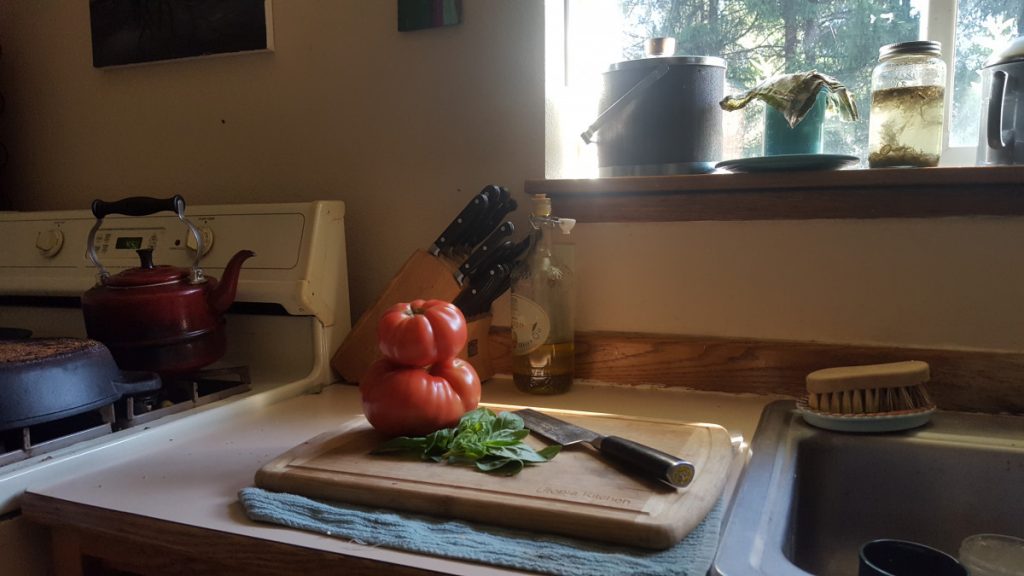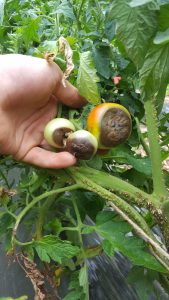Here we are again, I hope that this post finds the reader well.
A quick note: The WordPress platform for uploading photos has reached it’s capacity and will not allow me to upload any more pictures. I should be able to find some back up, WordPress storage space, and once I figure that out, I will have the varietal progression photos updated. In the mean time I am continuing my documentation and saving the photos.
It has been a hell of a week for the tomatoes. The weather has been absolutely beautiful, with highs in the upper 80s and sunny/dry for the majority of the week. In that time a few of the healthier varieties have put on well over a foot of new growth, the tallest plant is nearly at my chin (5’2″ ish). And even some of the sicker plants have seemed to fare well in the dry weather, putting on some new growth and a tomato-fruit or two, albeit still stunted. It’s been nice to see some fresh new shoots and bulging tomatoes throughout the plot.
All of this new growth has really put a premium on space, especially due to the cramped spacing that was necessary, due to the extenuating circumstances regarding available farm space. That is to say, the tomatoes are jammed into a small amount of space and now that they are pumping up new growth, over-crowding has become a true factor in this trial. To mitigate this I have been pruning the unnecessary leaves, especially near the bottom of the plants, to allow air flow and sunlight to penetrate deeper into the mass. Although it is fairly dry right now, the summer sun is limited and moisture issues will become a problem before too long, hopefully we will get at least two months before that will need to be addressed.
Aside from the usual varietal photos and plant observation notes, I spent the day pruning and trellising some of the varieties that had a growth spurt over the weekend. I am happy to say that the spread of disease seems to have halted for the time being and after pruning the plants pretty heavily, I feel confident that we will have a very important growth period over the next two weeks (weather permitting).
I did receive both of the pathology results of the plants that I sent into the WSU Extension Lab. I would love to post a photo of the results but that will have to wait until I can upload more photos. The first set of plants that I sent in concerning the mysterious wilting disease came back as positive for Verticillium Wilt… not so mysterious. The fact that there are multiple species of the Verticillium fungi leaves me less surprised that I couldn’t identify the common disease but at least we now know what is to blame. There are multiple plants that I am confident suffer from the Verticillium Wilt, each to a varying degree of severity. 17 plants in total are showing similar symptoms to the plants that were sent into the lab, all of which (except for perhaps 1) are currently putting on new growth.
As for the second pathology report concerning the potential Pith Necrosis, we got a positive ID on a Bacteria, but only to the Genus level, the species wasn’t made clear to me and I expect that the pathologists don’t know for certain. We can be sure, however, that a Pseudomonas bacterium has infected 5 individual plants. At the moment, the spread of this disease has halted within each of the plants; I am somewhat surprised that the plant has potentially stopped the spread of the bacteria for the time being, but that seems to be the case. Nearly all of the infected plant areas have been removed from the field and as far as I can tell, the disease has been kept at bay. *I don’t expect this to be the case for long*. It just shows you how important ideal conditions can be to making a healthy plant.
I want to touch base on the current condition of one variety in particular at this time. Both reps of the LB 21-7-4 variety have suffered through the entire trial. Through wet, warm and humid conditions, the plants all got hit rather hard with Early Blight. The giant burdock leaf shape (‘potato leaf’) of this variety is a great, large surface to catch spores that are floating through the air. With the Early Blight and subsequent removal of the leaves, the plant never quite recovered and is looking deathly ill. This is the case with both reps, all eight of the plants. While the southern plot is looking a shade more alive than the northern, it is only a matter of a short time until they succumb to the elements. I am going to save this variety for a while longer and continue to observe how the plants progress, but I expect to have to remove the plants sooner than later to ensure that they don’t assist in disease transfer. At this time I don’t expect them to yield any fruit so I feel comfortable ending that variety from the trial.
—
Both field plots are full of unripe fruit at this time, and I have enjoyed walking the rows, watching the fruit getting bigger and bigger each day. We are very close to the time of harvest! I will be gone for a majority of the week to the east side of Washington for a class field trip to some farming operations over there. I look forward to seeing the plants once I return.
Feel free to email me with any questions.



